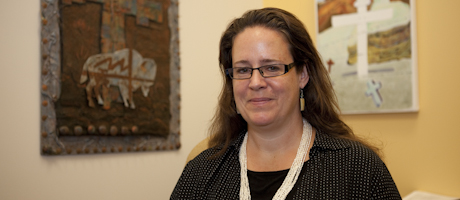Professor Elizabeth Warson helps Native people deal with cancer survivorship through art.
In 1992, Assistant Professor of Art Therapy Elizabeth Warson learned she had cervical cancer.
At the time, she was pursuing a master’s of arts in Vermont. Ill-informed about her diagnosis, Dr. Warson says after two surgeries she declined chemotherapy “out of fear.”
But now, Dr. Warson’s life work helps fellow Native cancer survivors manage those same feelings.
“[When I was diagnosed,] my experience was not so positive,” says Dr. Warson. “Because of this, I structured my research to offer social support in a group setting. Stress reduction has also been a focus of mine in both my clinical practice and research.”
A licensed professional counselor and board certified, registered art therapist, Dr. Warson works with American Indian and Alaskan Native cancer survivors and their families to provide them with stress reduction techniques as well as a “a nonverbal outlet for expression of feeling.”
“Many American Indians and Alaska Natives are reluctant to discuss their cancer diagnosis and treatment with those outside their family system,” she says. “We are looking at different culturally relevant approaches to enhancing quality of life factors for these cancer survivors.”
Her current research project—funded by an American Cancer Society grant, sponsored by the GW Cancer Institute— focuses on art-based stress reduction interventions, such as guided drawing exercises combined with mindful breathing exercises, “response” painting to induce a state of “flow,” visual journaling to promote self-care and clay work to reduce stress.
Dr. Warson says art therapy connects with the Native American concept of “wellness,” comprising, mind, body and spirit.
“Based on our preliminary data, the visual journaling and clay work seem to be their favorite interventions; that is, these are the art processes that they are continuing on their own,” she says. “They take it all to heart and are highly invested.”
It was Dr. Warson’s paternal grandmother who first inspired her to pursue art therapy. An American Indian, Francis Warson was also a licensed clinical social worker, painter, and published author.
“My grandmother has been my mentor throughout my academic training and career pursuits,” says Dr. Warson. “Ironically, my first position out of college was at an agency where my grandmother interned as a social worker during her graduate studies at Western Reserve.”
Dr. Warson’s American Indian heritage has always been an important part of her life as well.
Growing up in Tennessee and Colorado, she was active in the Native American community in both regions; however, her research often centers on tribes in the Southeast, because these communities are some of the most underserved areas in terms of cancer research.
Prior to joining GW in 2009, Dr. Warson was a clinician in northern Colorado where she worked with Native American families in urban and rural settings. She received a bachelor of fine arts from the Cleveland Institute of Art in 1989, a master’s of art in art therapy from Vermont College of Norwich University in 1993, and a doctorate in interdisciplinary studies from Colorado State University in 2008.
She joined GW’s graduate art therapy program because of its “long and rich history of infusing the arts in healthcare.”
“I was personally interested in GW’s program because of the diverse faculty, our emphasis on cultural competency, the new state-of-the-art facility and a commitment to initiating student-generated and faculty research,” she says.
Earlier this year, Dr. Warson received a National Endowment for the Arts grant in folk and traditional art for her community-driven Coharie Heritage Empowerment Project, which provides traditional art form instruction, including storytelling, quilting, basketry and carving, to the youth of the Coharie Tribe of Clinton, N.C.
She is also working on a project, “Healing Pathways: American Indian Medicine and Art Therapy,” sponsored by a GW’s Faculty Funds award. A sculptor, Dr. Warson has exhibited her work nationally and internationally and is a recipient of an Ohio Arts Council fellowship award. She is currently working on a mixed media series called “Native Epistemology,” or a Native way of knowing, in response to her research.
Dr. Warson says practicing art therapy with Native people and hearing their stories—including elders who are continuing their daily practice of visual journaling, cancer survivors who are integrating art making into their support groups, and children who are asking for art programs for their community— has “deeply inspired” her.
“I am continually reminded of how art therapy is life enhancing on many levels,” she says. “Speaking from a Native perspective, art is so much a part of life. Engaging in the expressive arts can be healing in every respect of the word.”


